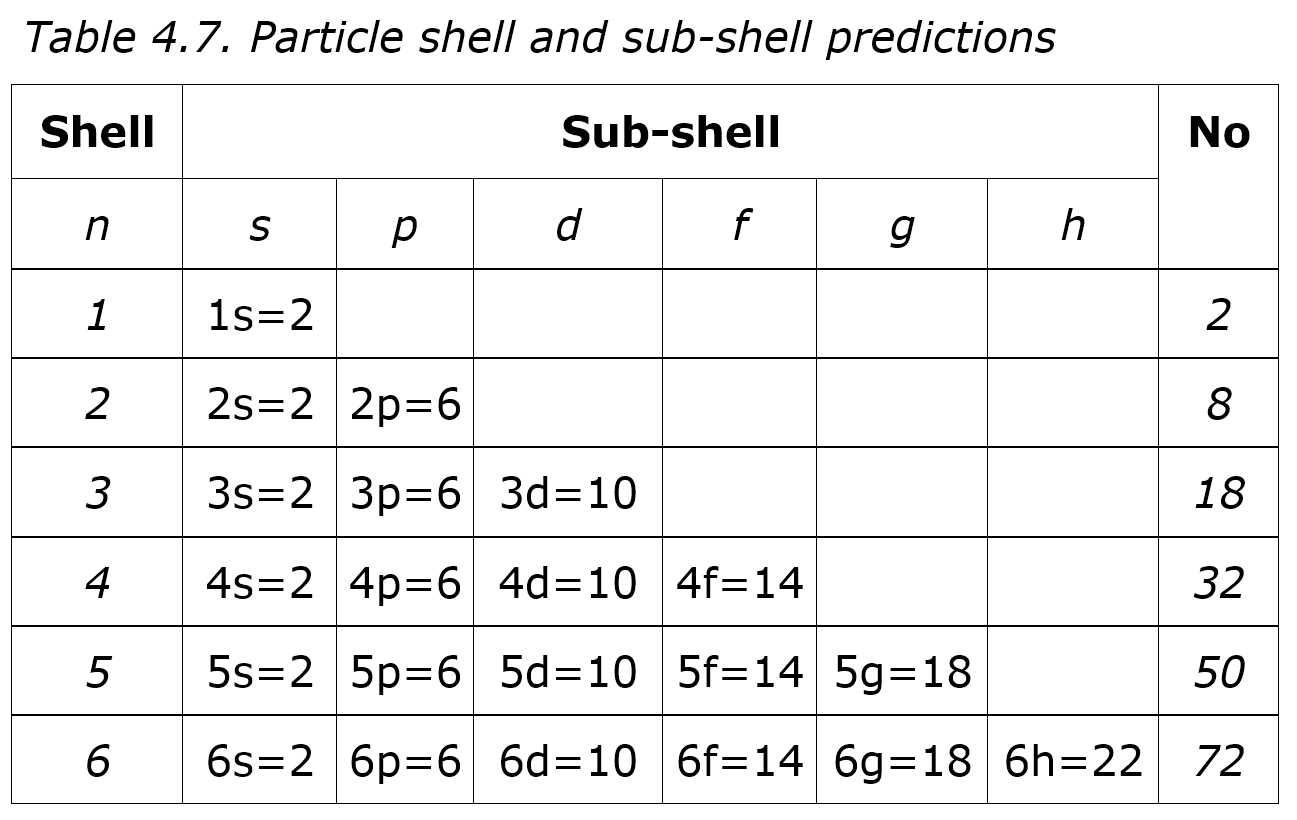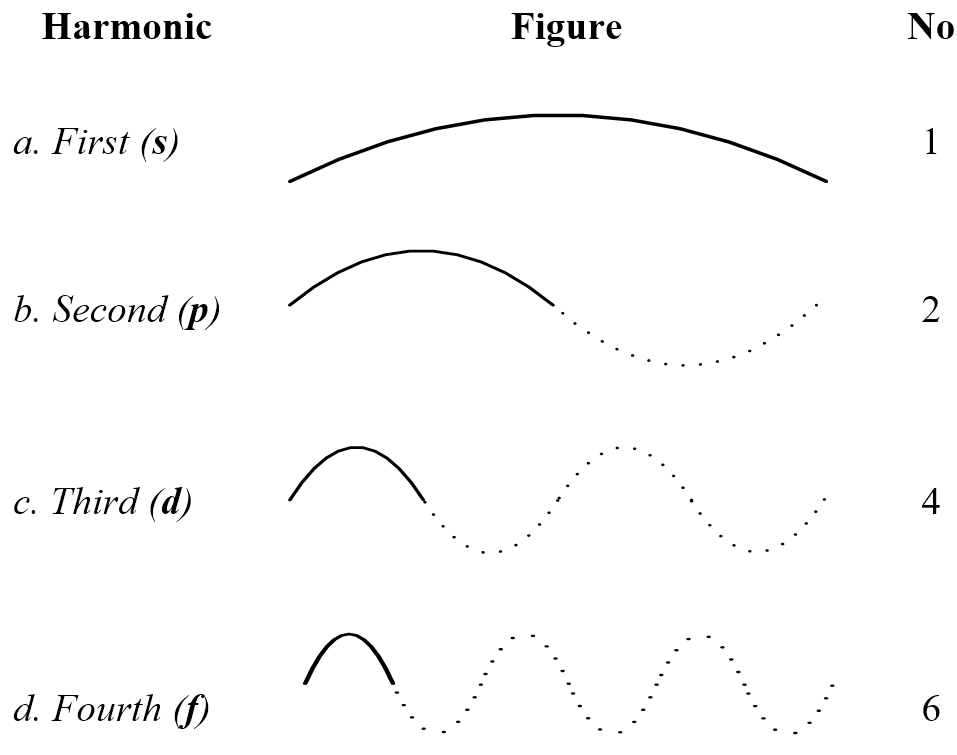The periodic table organizes matter elements based on electron shells. Each row represents an electron shell, that ends when it is full with an inert atom like Neon. Neon doesn’t exchange electrons with other atoms because its outer shell is full, but other atoms use chemical reactions, from acidity to oxidation, to exchange electrons to complete their outer shells. Stable molecules form when atoms with extra electrons donate them to those with a deficit, to complete their electron shells. The current description of electron shells is based on two quantum numbers:
1. Shell n (1, 2, 3 …). Initially the orbit radius.
2. Sub-shell l (s, p, d …). Has no agreed meaning.
The shells and sub-shells, deduced from spectroscopic analysis, are shown in Table 4.7, where sub-shells s, p, d, f, g, and h contain 2, 6, 10, 14, 18, and 22 electrons respectively. Bigger shell orbits fit more electrons, so doubling the first orbit quadruples its area to allow eight electrons, tripling it allows eighteen, quadrupling it thirty-two, and so on. Electrons then add to atoms based first on shells, then on available sub-shells, in order. Hence, the first row of the periodic table has two elements, and the second has eight elements, Lithium to Neon, but then there is a problem.

The third row of the periodic table is still just eight elements, including the carbon and oxygen of life, and the expected eighteen elements only occur in the next row. Quantum numbers predicted periodic table rows of 2, 8, 18, 32, 50, and 72, but instead the rows were 2, 8, 8, 18, 18, 32, and 32. So in the by now well-established practice, the model was tweaked so the sub-shells fill in this odd order:
Row 1: 1s Hydrogen-Helium (two elements)
Row 2: 2s, 2p Lithium-Neon (eight elements)
Row 3: 3s, 3p Sodium-Argon (eight elements)
Row 4: 4s, 4p, 3d Potassium-Krypton (eighteen elements)
Row 5: 5s, 5p, 4d Rubidium-Xenon (eighteen elements)
Row 6: 6s, 6p, 5d, 4f Cesium-Radon (thirty-two elements)
Row 7: 7s, 7p, 6d, 5f Francium-? (thirty-two elements)
Note that the third sub-shell 3d is pushed down to row 4, so generations of chemistry students had to learn that Argon completes the third shell without one of its sub-shells, which denies what a sub-shell is. If they asked why, the answer was because it is, as it must be for a model fitted to the facts.
In contrast, instead of rules based on abstract numbers, let electrons be waves with the properties:
1. Shell. The circumference around the atom nucleus that allows the electron wavelength.
2. Sub-shell. The harmonics that the shell circumference allows.
3. Direction. The wave direction, where waves at right angles don’t interfere.
In music, a wave harmonic arises when a wave fundamental lets other waves occur as well, so the fundamental and its harmonics overlap. A given electron shell can then also host harmonics, or sub-shells. Figure 4.23 shows a fundamental that has harmonics, where the number at the right is how many waves the harmonic allows.

Sub-shells as wave harmonics then explains the rows of the periodic table as follows:
1. The first shell is the circumference that lets a wave vibrate up and down on alternate cycles (Figure 4.23a). In this model, light has a minimum wavelength that can’t be reduced, so there is only one fundamental, called the 1s sub-shell. But a spherical orbit allows two directions at right angles, so it allows two waves at right angles that don’t interfere. The first shell then has one or two electron waves, so the first periodic table row is Hydrogen and the inert gas Helium.
2. The second shell circumference is double that of the first, and allows harmonics. The first is a fundamental that alternates up and down, giving a 2s sub-shell that can hold two electrons. The second harmonic (Figure 4.23b) allows two more waves at once, which for two directions is four electrons, and the complex harmonics of two-dimensional waves seen on a drum surface allow two more electrons, giving six in total for the 2p sub-shell. The second shell then allows eight electron waves, giving the second row of the periodic table, Lithium to Neon.
3. The third shell circumference is triple that of the first, so it has a one and a half times the first wave-length. This again allows 3s and 3p sub-shells but a third harmonic can’t occur. A bipolar (up-down) wave can vibrate once on a string half its wavelength, and twice on a string of its wavelength, but a string one and a half times that gives nothing more, so there is no 3d sub-shell. Adding a half-wavelength adds no new harmonics so the third shell, like the second, only has eight electrons, giving eight elements in the periodic table third row.
4. The fourth shell is a two-wavelength circumference that quadruples the first. This allows a new harmonic that accommodates four waves, which for two directions is eight electrons (Figure 4.23c), plus two complex harmonics is ten. The 4s, 4p, and 4d sub-shells then give 18 elements in the periodic table fourth row, as observed.
5. The fifth shell, like the third, allows no new harmonic, so its 5s, 5p, and 5d sub-shells repeat the previous total of eighteen, giving the periodic table fifth row, again as observed.
6. The sixth shell allows a fourth f harmonic with six electrons (Figure 4.23d) which doubled is twelve, plus two complex harmonics is fourteen. This plus eighteen from the s, p, and d harmonics gives the thirty-two elements of the sixth periodic table row that include the Lanthanide series.
7. The seventh shell again has no new harmonic so it also has 32 elements, including the periodic table Actinide series.
An electron wave model based on sub-shell harmonics then fills the periodic table as follows:
1. 1s Hydrogen-Helium (2 elements)
2. 2s, 2p Lithium-Neon (8 elements)
3. 3s, 3p Sodium-Argon (8 elements)
4. 4s, 4p, 4d Potassium-Krypton (18 elements)
5. 5s, 5p, 5d Rubidium-Xenon (18 elements)
6. 6s, 6p, 6d, 6f Cesium-Radon (32 elements)
7. 7s, 7p, 7d, 7f Francium-? (32 elements)
Now the third shell has no 3d sub-shell and the fourth shell has no 4f sub-shell, so electrons fill shells and sub-shells in a logical order. Compare this to the strange order implied by Klechkowski’s rule based on quantum numbers (Figure 4.24), where the 3d sub-shell fills after the 4s sub-shell.
Electrons now fill shells based not on invented numbers but on how waves behave, where:
1. Shell. The first shell circumference is the minimum electron wavelength and larger shells multiply this.
2. Sub-shell. Sub-shells are wave harmonics, where s is the first, p is the second, and so on.
3. Direction. The great circle axis orientation, where orthogonal waves don’t interfere.
Electrons then fill in the order shown in the periodic table, based on:
1. Shell. Each shell is a bigger orbit, which for an electron with mass requires more processing and so more energy. Shells then fill in the order 1, 2, 3 … with smaller orbits first.
2. Harmonic. Each new sub-shell harmonic is a shorter wavelength, so it again needs more energy. Sub-shells then fill in the order s, p, d … with lower harmonics first.
Electron shells and sub-shells based on wave harmonics predict the periodic table better than quantum numbers, as a causal model is better than a descriptive model that is tweaked to work.